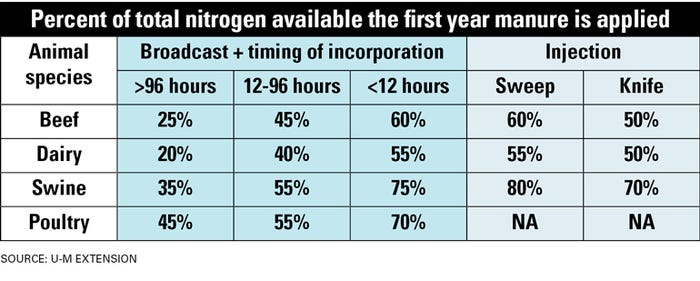
University of Minnesota scientists have updated manure application rate guidelines to reflect recent research findings for nitrogen and phosphorus needs of crops.
Melissa Wilson, U-M Extension manure management specialist, says both nitrogen and phosphorus have updates. The corn nitrogen guidelines were updated for nonirrigated soils. These guidelines use the maximum return to nitrogen (MRTN) approach, which relies on calculating the price ratio for the cost per pound of nitrogen divided by the value of corn per bushel.
As one example, the maximum amount of plant-available nitrogen (PAN) that should be applied with manure is 195 pounds of PAN per acre in a continuous corn system. This corresponds with the suggested 0.05 price ratio MRTN — the maximum rate of manure nitrogen that should be applied.
“We recommend this for farmers that have access to free or cheap manure,” she says.
For crop farmers and organic farmers who may be paying for the manure, Wilson says it may make more economic sense to use the 0.1 MRTN value of 165 pounds of PAN per acre in a continuous corn system.
“Those with lower-productivity soils or other environmental concerns in a field may also want to consider using a lower application rate than our suggested maximum,” she says. “Manure is a valuable source of nutrients — more than just nitrogen, phosphorus, potassium — so maximizing its efficiency is important.”
More details about fertilizing corn and the various MRTN recommendations are available at U-M Extenstion.
Phosphorus update
Wilson says more producers are interested in applying manure in a way that limits the buildup of phosphorus in their soils.
“One way to do this is to base manure application rates on replacement of phosphorus that will be removed from the soil by the [harvested] crop. The updated manure application rate guidelines cover the steps to do this,” she says.
Wilson reminds farmers that not all nitrogen or phosphorus in manure is available the first year, and that manure availability is impacted by animal species.

This table helps explain the differences in first-year N availability in beef, dairy, swine and poultry manure to crops.

Some N or P is plant-available right away, and some is tied up in the organic matter, eventually breaking down to become plant-available. And typically, swine and poultry tend to have the most nitrogen available the first year, while beef and dairy manure release the nitrogen more slowly, she says.
“It is important to calculate the first-year PAN or plant-available phosphorus in order to figure out application rates,” Wilson says.
Another important step in calculating application rates is to consider all sources of nitrogen to the crop. This includes nitrogen from irrigation water, credits from manure or other organic nitrogen sources that were applied in the past two years, and credits from legumes.
“Research across the Midwest has shown that applications of nitrogen above the economically optimum nitrogen rate for a crop significantly increases nitrogen leaching,” she says.
Also, check out these resources from U-M Extension:
About the Author(s)
You May Also Like






